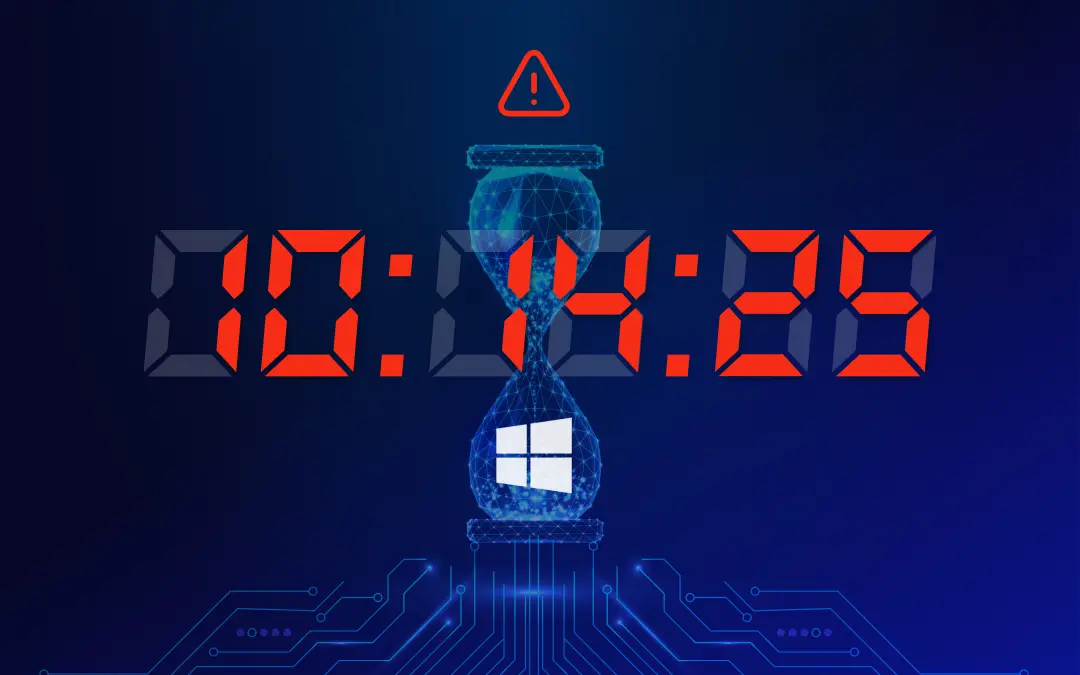What SMBs must do before Windows 10 support ends
A reliable, cloud-based endpoint backup solution is crucial, to protect data from multiple failure points during the transition.
Olivia Pramas
August 19, 2025

On October 14, 2025, Microsoft will officially end support for Windows 10. That means no more security patches, bug fixes, or technical updates.
For small and mid-sized businesses (SMBs), this deadline brings real consequences: unsupported systems expose you to increased cyber risk, compliance gaps, and potential denial of cyber insurance coverage. Most businesses can't afford to wait. With 50% of business-managed PCs still running Windows 10, the clock is ticking.
If you're wondering what your organization should do before Windows 10 support ends, this article walks you through the critical steps.
Step 1: Take inventory of every Windows 10 device
You can’t upgrade what you can’t see. The first step is to identify every Windows 10 machine in your environment, especially those outside the office network.
Create an inventory that includes:
- All company-owned desktops, laptops, and workstations.
- Devices used by remote workers or contractors.
- Key specs like device type, age, processor, RAM, and storage.
- Compatibility with Windows 11 requirements, including TPM 2.0 and Secure Boot.
This is often where reality sets in. Many SMBs discover that a large portion of their PCs are running on outdated or unsupported hardware. Without a complete inventory, upgrade plans can stall or overlook critical systems.
Step 2: Build Your Upgrade and Replacement Plan
Once you’ve mapped your environment, you’ll need a clear plan for what gets upgraded, what gets replaced, and when. Don’t wait until the last minute — hardware supply chain delays and OS compatibility issues can slow you down.
To make the transition as smooth as possible, consider the following paths:
- For eligible devices: Schedule upgrades during low-usage periods and run application testing in advance to prevent disruption.
- For legacy hardware: Plan for phased replacement, starting with systems that support critical operations or contain sensitive data.
- For complex environments: Work with your MSP or IT partner to streamline purchasing, image management, and deployment.
A structured plan reduces downtime, controls costs, and avoids surprises.
Step 3: Back up your endpoint data
Whether you're upgrading an OS or replacing devices entirely, data loss is a real risk. Even a small misstep during migration can result in corrupted files, failed restores, or ransomware exposure, especially if you're still running unpatched Windows 10 systems in the meantime.
Backups protect against:
- Hardware failures during upgrade.
- Cyberattacks targeting unsupported devices.
- Lost or stolen laptops used by remote staff.
Use this time to implement—or validate—a reliable, cloud-based endpoint backup solution. Look for cloud-based, low-touch solution designed for SMBs and MSPs that offer automatic backups, simple restore workflows, and centralized management that fits MSP or lean IT team models.
You need backup not simply as a recovery tool, but as a control that protects your data from multiple failure points during the transition.
Step 4: Review your cyber insurance requirements
Cyber insurers are raising the bar and unsupported operating systems are high on their list of red flags. If your business files a claim after October 2025 and you're still running Windows 10, you could be denied coverage outright.
Underwriters increasingly require evidence of secure configuration, documented patching, and up-to-date endpoint protection. Businesses without clear backup policies or transition timelines may also see premiums spike or lose eligibility altogether.
Protect your policy by demonstrating that you’re actively reducing risk, not prolonging it.
Step 5: Prepare and train your employees early
Device upgrades can cause confusion and frustration, especially if timelines shift or tools change. Employees need to understand what’s happening, when it’s happening, and how it impacts their day-to-day work.
Communicate early and clearly. Provide replacement timelines, step-by-step instructions for data access during cutovers, and refreshers on secure file handling. For hybrid and remote teams, make sure support channels are in place to handle issues fast.
Technology changes are rarely smooth, but clear communication keeps disruptions to a minimum and prevents user behavior from introducing new risks.
Don’t wait until October 2025
Windows 10 end of life is more than a Microsoft deadline—it’s a major shift in your business’s risk surface. Procrastination means exposure. But a few smart moves now can keep your business secure, your devices protected, and your insurance intact.

Olivia Pramas
Olivia is passionate digital marketing leader, driving the OpenText Cybersecurity brand and messaging.